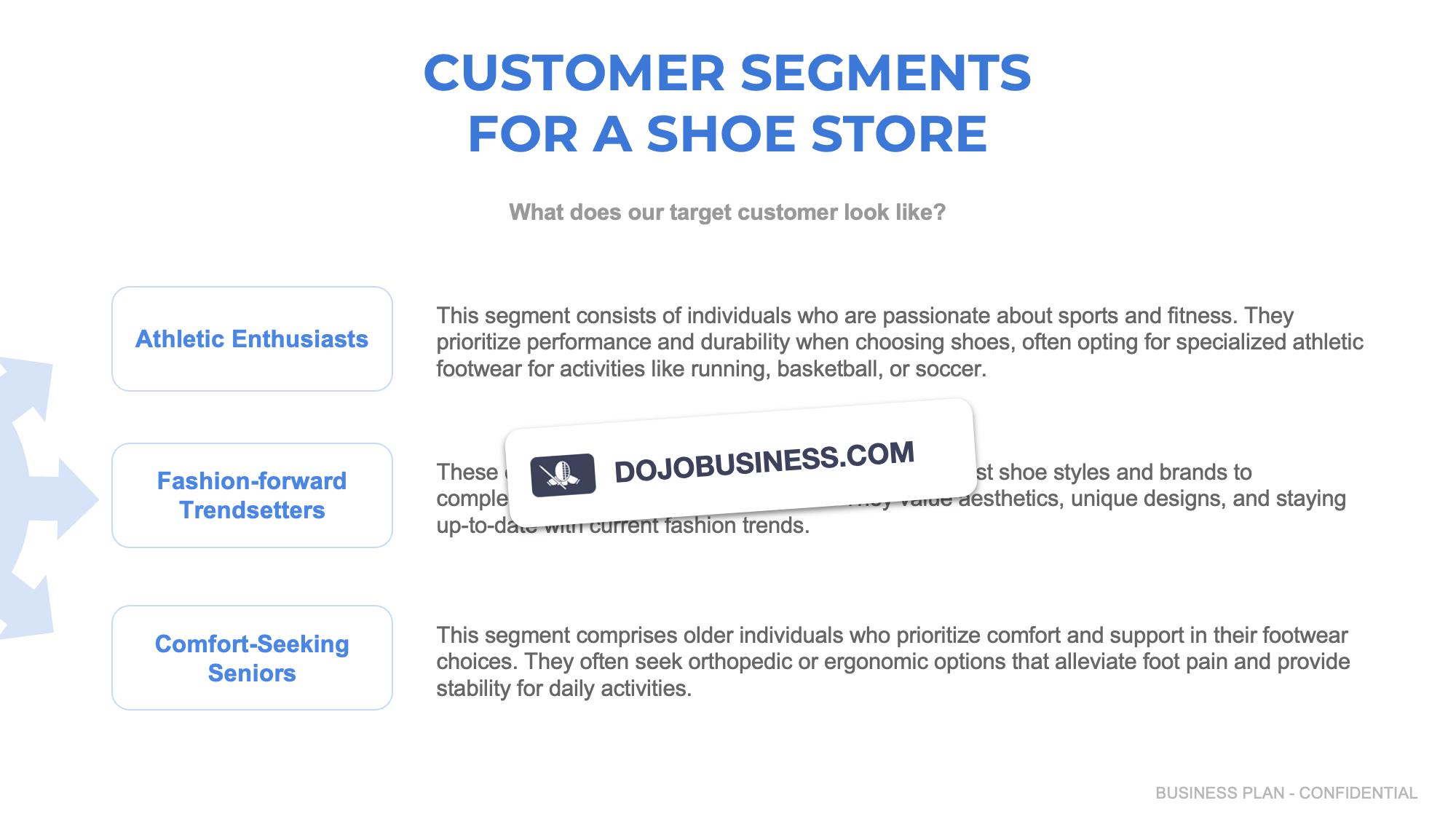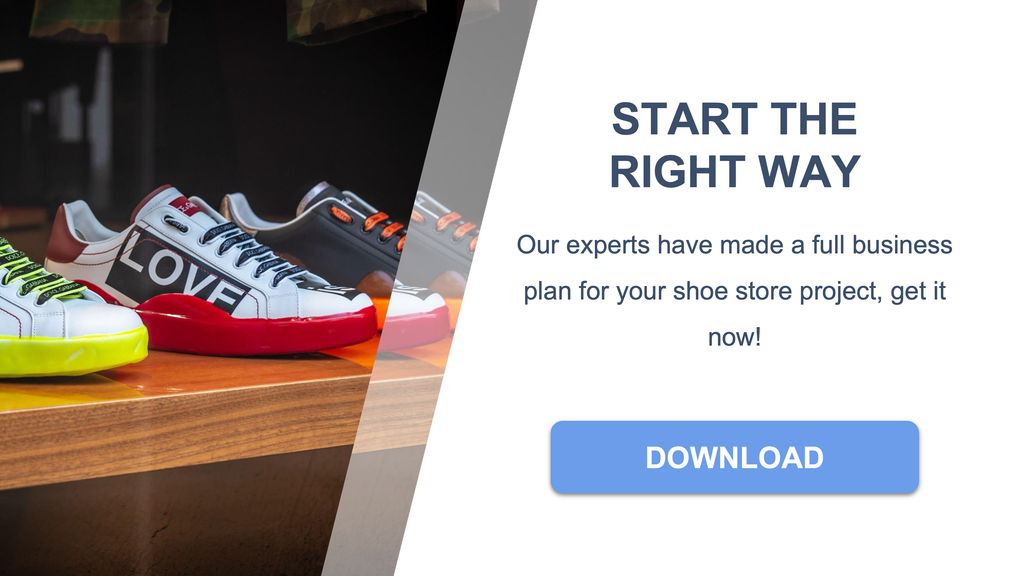
Get a watermark-free, fully customizable customer segmentation in our business plan for a shoe store
Knowing your shoppers is essential for any thriving shoe store.
Let us walk you through the steps of recognizing and understanding your main customer groups to fine-tune your inventory and promotional strategies.
By identifying who your shoppers are and what they're looking for, you can ensure your shoe store not only draws in but also pleases an array of footwear enthusiasts.
And, if you're in search of a ready-made customer segmentation that's fully customizable, feel free to check out our business plan template designed for a shoe retail venture.
What is exactly a "customer segmentation"? Should you make one for your shoe store?
Customer segmentation is the strategy of categorizing your shoe store's potential and existing customers into distinct groups based on common characteristics.
Think of it as crafting a detailed profile for your shoppers, from basic demographics like age and gender to more specific interests such as fashion trends or athletic needs. The aim is to grasp the varied requirements and purchasing habits of your customer base, enabling you to customize your products, services, and marketing efforts to each unique group.
Why do shoe store owners and marketers invest time in customer segmentation? Simply put, not every shopper has the same taste or requirements.
Different segments may seek different styles, comfort levels, and price points when it comes to footwear. By pinpointing these segments, you can fine-tune your inventory, store layout, and promotional strategies to connect directly with each group's preferences and expectations.
For instance, a segment focused on athletic footwear might appreciate a wide selection of running shoes and performance features, while a fashion-forward segment may prioritize the latest trends and designer labels.
The advantages of effective customer segmentation, similar to what you'll discover in our business plan template tailored for a shoe store, are significant and impactful. It leads to more precise marketing, potentially increasing sales conversions and optimizing your advertising spend.
Aligning your product range and service offerings to the distinct needs of different customer segments can boost satisfaction and foster brand loyalty. Plus, understanding your customer segments can inform your stock choices, store design, and customer service improvements, positioning your shoe store as the go-to destination for varied shopper profiles.
Should you implement customer segmentation if you're launching a new shoe store? Definitely.
Knowing who your customers are and what they seek from the start can provide you with a substantial advantage. It allows you to shape your store concept, inventory, and marketing plans with a clear focus on catering to the needs of your target segments. This strategic approach can help you swiftly build a devoted customer base and stand out in a competitive retail landscape.
Is customer segmentation useful for you? Undoubtedly. Whether you're in the initial planning phase or aiming to expand an existing shoe store, recognizing the different segments within your customer base is crucial for making savvy decisions. It affects everything from the promotions you run to the training you provide your staff.
Furthermore, customer segmentation is not a set-it-and-forget-it activity; it's a continuous practice. As consumer trends shift and your business grows, regularly revisiting and refining your customer segments can ensure that your shoe store remains aligned with the evolving tastes and needs of your shoppers.

How to segment customers for your shoe store?
To create customer segments for your shoe store, begin by examining your customer data to uncover patterns and common characteristics, such as age, fashion preferences, and purchasing behavior.
Next, categorize customers into segments based on these shared attributes to customize marketing approaches and product selections to cater to each group's unique tastes and needs.
To streamline the process for you, here is a 10-step action plan to develop a meaningful customer segmentation for your shoe store.
| Step | Action | Details |
|---|---|---|
| 1 | Collect customer information | Gather data through loyalty programs, sales transactions, and online interactions. |
| 2 | Examine buying patterns | Analyze which types of shoes are popular, purchase frequency, and average spend. |
| 3 | Determine demographic factors | Group customers by age, gender, income level, and other demographic details. |
| 4 | Assess psychographic elements | Segment customers by personality, lifestyle, and fashion sensibilities. |
| 5 | Consider geographic data | Divide customers based on their residential or workplace locations. |
| 6 | Develop customer profiles | Create detailed personas for each segment to better address their preferences. |
| 7 | Calculate customer value | Assess the long-term value and profitability of each customer group. |
| 8 | Identify target segments | Select the customer groups to prioritize based on their potential value and alignment with your store's objectives. |
| 9 | Customize marketing tactics | Formulate specialized marketing plans tailored to the interests of each segment. |
| 10 | Adjust and update segments | Continuously review and modify your segments to reflect evolving customer trends and business goals. |
What are some examples of audiences and customer segments for a shoe store?
Below is a table with 10 examples of customer segments for a shoe store.
| Name of the Segment | Description | Preferences and Budget |
|---|---|---|
| Sports Enthusiasts | Individuals who are actively involved in sports or fitness activities and are looking for performance footwear. | Medium to high budget, prefers high-quality, durable sports shoes with specific features for their activities. |
| Fashion-Forward Shoppers | Customers who follow the latest fashion trends and are looking for stylish footwear to complement their wardrobe. | Medium to high budget, prefers trendy designs and brand-name shoes. |
| Budget-Conscious Consumers | Shoppers seeking affordable footwear options without compromising on style or quality. | Low to medium budget, prefers sales, discounts, and value-for-money purchases. |
| Professionals | Working adults in need of formal or business-casual shoes for the workplace. | Medium to high budget, prefers comfortable, classic styles that are suitable for long hours of wear. |
| Outdoor Adventurers | Individuals who enjoy outdoor activities and require sturdy, weather-resistant footwear. | Medium to high budget, prefers durable, supportive shoes with features like waterproofing or insulation. |
| Parents and Children | Families looking for shoes for their children, from toddlers to teenagers. | Varied budget, prefers durable, comfortable shoes with appealing designs for kids. |
| Comfort-Seekers | Customers who prioritize comfort due to lifestyle or health reasons, such as seniors or those with foot ailments. | Low to medium budget, prefers shoes with good arch support, cushioning, and easy-to-wear designs. |
| Eco-Conscious Shoppers | Individuals who are mindful of the environmental impact of their purchases and seek sustainable footwear options. | Medium to high budget, prefers shoes made from eco-friendly materials and ethical production practices. |
| Sneaker Collectors | Enthusiasts who collect limited edition and exclusive sneaker releases. | High budget, prefers rare finds, limited releases, and collector's items. |
| Special Occasions | Customers looking for footwear for specific events such as weddings, proms, or formal gatherings. | Medium to high budget, prefers elegant, high-quality shoes that complement formal attire. |

Examples of customer segmentation for a shoe store
Below are three different (very concise) examples of customer segmentations tailored for a High-End Boutique Shoe Store, a Family Shoe Store, and an Athletic Shoe Store.
High-End Boutique Shoe Store Customer Segmentation
| Customer Segment | Characteristics |
|---|---|
| Fashion-Conscious Professionals | Seeks the latest trends in footwear, values quality craftsmanship and designer labels. |
| Luxury Shoppers | Desires exclusive and high-end shoes, willing to invest in premium materials and unique designs. |
| Special Occasion Buyers | Looking for elegant footwear for events such as weddings, galas, and formal parties. |
| International Tourists | Interested in acquiring shoes from renowned local designers, often seeking a memorable shopping experience. |
Family Shoe Store Customer Segmentation
| Customer Segment | Characteristics |
|---|---|
| Parents with Children | Looking for durable, comfortable, and affordable footwear for growing kids. |
| Budget-Conscious Shoppers | Seeks value for money, interested in promotions, discounts, and functional footwear. |
| Multi-Generational Families | Needs a variety of styles and sizes to accommodate all family members from children to seniors. |
| Back-to-School Shoppers | Seeks practical, sturdy shoes for the school year, often looking for deals on multiple pairs. |
Athletic Shoe Store Customer Segmentation
| Customer Segment | Characteristics |
|---|---|
| Amateur and Professional Athletes | Requires specialized footwear for specific sports, values performance and technology in shoes. |
| Fitness Enthusiasts | Interested in shoes that provide support and comfort for various workouts and fitness activities. |
| Health and Wellness Advocates | Looks for shoes that promote good posture and healthy walking habits, may be interested in eco-friendly options. |
| Outdoor Adventure Seekers | Seeks durable and protective footwear for hiking, trail running, and other outdoor activities. |

You can also read our articles about:
- how to fill a Business Model Canvas for your shoe store
- how to study the competitors of your shoe store
- how to elaborate a marketing strategy for your shoe store
- how to open a shoe store (guide)
